History
Walt Disney hated McDonald’s?! What a Kroc … er … crock.
Knowing that this story is sure to offend a few Disney purists out there, Jim Hill still spills the beans about the Walt Disney Company’s real relation with the McDonald’s Corporation. First off, he talks about the early years – for both Disneyland as well as the fast food chain.
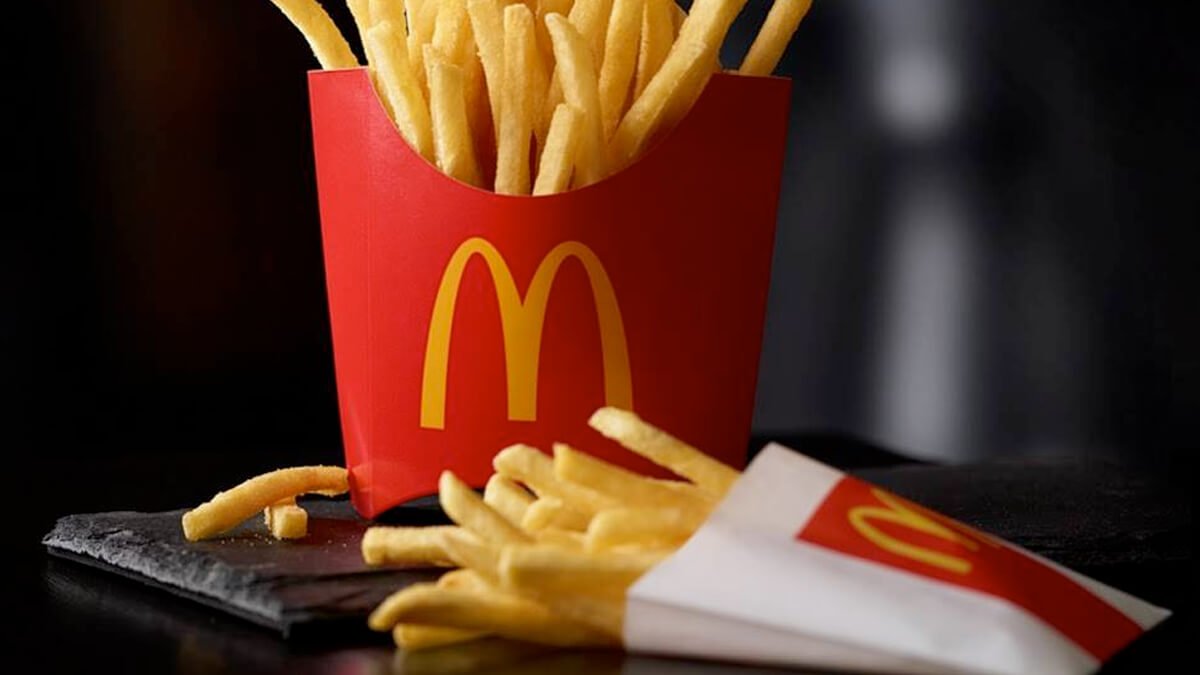
You know, just because I write about the Walt Disney Company, I get some VERY interesting mail.
Sometimes, it’s letters from people who are sharing secrets about various projects that the Mouse currently has in the works (EX: Even more juicy inside info on “Destination Disney” came rolling in yesterday. So I promise that I’ll try to do another story on this most intriguing soon-to-debut-at-WDW program next week, okay?). And sometimes, it’s e-mail from folks who are hoping that I’ll champion their Disney-related cause.
For example: Just yesterday, I found a note in my in-box from this guy (let’s call him Joe) who clearly doesn’t like McDonald’s. Here’s a quote from Joe’s e-mail:
“(McDonald’s) has absolutely no business doing business inside of the Disney theme parks. After all, everyone knows that Walt Disney hated fast food places. Walt would have had a fit if he knew that Eisner was allowing that fast food company to sell French Fries inside his beloved Disneyland.”
Sorry, Joe. But you’re not exactly on the money when it comes to describing how Walt Disney felt about fast food. To be honest, according to this great little book that I just finished reading (D. W. Miller’s What Would Walt Do?: An Insider’s Story about the Design and Construction of Walt Disney World. Look for a review of this thin but fun volume this coming Thursday on JimHillMedia.com), Walt just loved fast food. Particularly the stuff that was served at McDonald’s.
In his book, Miller tells about how — in the early 1960s, as Walt was flying around the country (I.E. Taking part in the land search for Disney World, meeting with executives for the 1964 New York Worlds Fair, etc.) aboard Mickey Mouse One — he’d sometimes start to feel a little hungry. When that happened, Disney would reportedly amble up to the cockpit and ask the pilot: “Where are we?”
The pilot would answer by saying something like “We’re over Tulsa, Walt.” Or Bayonne. Or Boise.
Disney would then follow his first question with a second. “Is there one down there?”
With that, the pilot would consult a booklet that listed the location of every single McDonald’s in the continental United States. If there was one of these restaurants down in the city that the Disney corporate plane was flying over, Walt would then order the pilot to land. Once they were safely on the ground, Disney would call for a cab.
And with that, Walt and his traveling party would head out for the nearest McDonald’s to get a bite to eat.
Not exactly what you wanted to hear, is it, Joe? Wait. It gets worse. Have you ever heard the (perhaps apocryphal) story about how — if restaurant chain founder Ray Kroc had been willing to jack his prices up by just a nickel — the world’s very first McDonald’s might have been built right inside of Disneyland?
Strange but allegedly true, kids. And I promise that I’ll get this flat out bizarre “What If” story in just a moment. But in order to tell this tale properly, I have to give you a little deep background first.
You see, the parallels between Walt Disney and McDonald’s founder Ray Kroc’s lives are beyond spooky. EX: Walt and Ray were both from Illinois (Disney was born in 1901, Kroc born in 1902). And — when they were teenage boys — both men lied about their age so that they could enlist in the Red Cross ambulance service during World War I.
Weird? Wait. It gets weirder. Disney and Kroc end up getting assigned to the very same unit: Ambulance Company A (which actually shipped out for France right after the Armistice was signed in 1918). And while they’re overseas, these two boys from the Midwest strike up … well, not exactly a friendship. But at least an acquaintance-ship.
At the very least, Ray knew young Walt well enough to describe the future movie mogul thusly in his 1977 autobiography, Grinding It Out: The Making of McDonald’s: “(Disney) was regarded as an odd duck, because whenever we had time off and went out on the town to chase girls, (Walt) stayed in camp drawing pictures.”
Eventually, Ray and Walt both returned to the US. They both quickly abandon the Midwest, heading out to Southern California to seek fame and fortune.
It’s here that Kroc and Disney’s paths divide. After five years full of tough breaks and back breaking effort, Walt finally does achieve some fame and fortune — thanks to “Steamboat Willie.” This single short — the first cartoon with synchronized sound — puts Disney on the road to success.
Whereas Ray … well, it would be another 26 years of hustling and hard selling before his big break finally arrived. The day when Kroc — who was then a salesman for the Mixmaster Corporation — met up with Richard and “Mac” McDonald, two brothers who were having tremendous success with their San Bernadino, CA restaurant thanks to its innovative “Speedee Service System.”
Ray got one glance at the McDonalds brothers’ food production methods — where all the burgers at their restaurant were cooked and put together assembly-line-style, in order to get the low cost eats out to the customers as quickly as possible — and immediately saw the potential of the system. Which is why Kroc begged Richard and “Mac” to award him the rights to set up other restaurants around the country that would feature the McDonalds brothers’ “Speedee Service System.”
The only problem was that the McDonalds brothers weren’t all that eager to cash in on their idea. In fact, only a few months before Ray arrived on the scene, Richard and “Mac” rejected a similar offer from the Carnation Milk Company. But Kroc was so persistent that the McDonald brothers eventually caved and awarded this 52-year-old salesman the rights to use their “Speedee Service System.”
Now Ray just knew that — with the proper placement and promotion — that his concept for a national chain of fast food restaurants would be a huge success. But the only way to guarantee that success was to find just the right location to launch the McDonald’s chain from. Some place that would give the franchise’s “Speedee Service System” plenty of exposure.
Well, it was just about this time — April 1954 — that Walt Disney unveiled his plans for Disneyland; a bold new concept in family fun parks. And as soon as Ray heard about what his old “war buddy” was up to, Kroc knew that he’d finally found the perfect place to build his first McDonald’s franchise.
Which is why — in late 1954 — Ray sent the following letter to Walt. In part, it read:
Dear Walt,
I feel somewhat presumptuous addressing you in this way. Yet I am sure you would not want me to address you any other way … My name is Ray A. Kroc … I look over the Company A picture we had taken in Sound Beach, Conn. many times and recall a lot of pleasant memories.
Okay. Having buttered up his old “war buddy” a bit, Kroc — the super salesman — now moves in for the kill.
I have very recently taken over the national franchise of the McDonald’s system. I would like to inquiry if there may be an opportunity for a McDonald’s in your Disneyland Development.
Kroc’s concept was that — given the ten of thousands of people who were sure to flock to Disneyland once the theme park actually opened — Walt was going to need a restaurant that would be able to quickly feed crowds of this size. Ray insisted that the McDonald brothers’ “Speedee Service System” would be up to this daunting task, churning out hundreds of hot, fresh, tasty hamburgers every hour. Which could then be sold for a very affordable price.
Walt responded quite cordially to Kroc’s note, then told the former Red Cross ambulance driver that he would be handing Ray’s proposal over to the Disneyland executive who was in charge of Disneyland’s concessions. And after that … well … the story gets kind of murky.
I mean, we all know that the world’s first McDonald’s franchise DIDN’T open at Disneyland back in July of 1955. But as to why this deal between two old “war buddies” didn’t go through … well, there are a number of theories.
For example: To his dying day, Ray Kroc insisted that the real reason that the world’s first McDonald’s was NOT among the assortment of eateries that was found inside Disneyland when the park first opened on July 17, 1955 was because Disneyland executives had tried to force Ray to raise the prices of the food that he would be selling at his inside-the-berm restaurant.
To be specific, Kroc supposedly balked because the head of Disneyland concessions had insisted that Ray raise the price of a single order of McDonald’s French Fries from 10 cents to 15 cents. The idea behind this particular price boost was that — by adding that extra nickel to the cost of the fries — Walt Disney Productions was, in effect, tacking on a concessionaire’s fee. As in: Ray could keep 10 cents out of the 15 cents that he charged for his French Fries. But that other nickel would go straight into Disneyland’s coffers.
To hear Kroc tell this story: Ray hit the roof as soon as he heard about this. Kroc insisted that he would never deliberately price gouge his patrons, overcharge customers for food just so Walt Disney Production could make an extra 5 cents off of every bag of French Fries that he sold. To do this would be a disservice to McDonald’s loyal customers. Which is something that Ray just couldn’t bring himself to do. Break that sacred trust. Which is why Kroc says he decided to back out of the Disneyland project.
Which — you’ll have to admit — is a very colorful, most entertaining yarn. The only problem with Kroc’s version of events is that as of early 1955, Ray hadn’t actually opened a McDonald’s restaurant franchise yet. So there were no “loyal customers” yet to be deeply offended by Disney’s insistence that Kroc raise the price of the French Fries he was selling. So Kroc’s story appears to be … well … a krock.
A more likely scenario was that the executive in charge of Disneyland’s concessions was probably rather intrigued by Ray’s proposal. But since (as of late 1954 / early 1955, anyway) Kroc hadn’t actually run a restaurant yet (Ray’s very first McDonald’s franchise — a restaurant that would eventually be built in Des Plaines, Il. — wouldn’t even open its doors ’til April 15, 1955), it just didn’t make sense for Walt Disney Productions to award a concession contract of this size to a neophyte like Kroc. Whether Ray was a “war buddy” of Walt’s or not, a move like this just wouldn’t have made much business sense.
So — in spite of what Ray Kroc may have repeatedly told reporters from the 1950s on forward — Disneyland veterans that I’ve spoken with over the years insist that there never were any serious plans to open a McDonald’s inside Disneyland back in 1955. Sure, there was some discussion of building a restaurant just like this inside the theme park. But Disneyland’s fast food project never really made it past the talking stage.
Mind you, Ray Kroc was not the sort of guy who’d let the truth stand in the way of a good story. (That’s just the salesman way, folks. To embroider a story. To expand an anecdote until it becomes an epic. To take a kernal of truth and stretch it into a whopper of a tale.) So over the next 15 years, Kroc told this crock over and over and over. Until (evidently), Ray began to believe this story himself. Which is why McDonald’s founder reportedly began to nurse a wee bit of a grudge toward Walt Disney Productions.
And longtime McDonald’s Corporation employees will tell you that it was NEVER a wise move to get Ray Kroc angry. Why? Because Kroc allegedly was one of these guys who was quick to anger and very slow to forgive.
To put this somewhat politely, Ray Kroc was kind of an SOB. A ruthless, driven businessman who could be absolutely brutal with his competition. In one of Ray’s more infamous interviews, McDonald’s chairman was quoted as saying that — when it came to his business philosophy — it was “rat eat rat, dog eat dog.” Talking about his competitors in the fast food field, Kroc said “I’ll kill ’em and I’m going to kill ’em before they kill me. You’re talking about the American Way of (doing business), survival of the fittest.”
As I mentioned earlier, Ray was known for nursing a grudge. Perhaps his most infamous piece of payback involved the McDonalds brothers. “What beef could Ray Kroc possibly have with the inventors of the McDonald’s hamburger?,” you ask. Well, under the terms of the franchise agreement that Kroc had with Richard and “Mac,” Ray was responsible for the entire expansion process for the fast food chain, while the brothers retained control of the restaurant’s production process. More importantly, Richard and “Mac” got a 0.5% share of the corporation’s profits. Which — thanks to all of Ray’s hard work — had made the McDonalds very wealthy men.
Unfortunately, by 1961, Kroc had grown frustrated with this arrangement. He felt that the McDonald’s brothers were making far too much money off of his efforts. Which is why Ray offered to buy Richard and “Mac” out.
After some fairly protracted negotiations, the McDonalds brothers agreed to sell the business to Kroc if he gave each of them one million dollars in tax free cash. That “tax free” condition is what eventually drove Richard and “Mac”‘s pay-out price up to $2.7 million. Which was a hell of a lot more than Ray had planned on spending to finally gain total control of the restaurant chain that he had built.
According to the terms of the McDonald’s Corporation sales agreement, Richard and “Mac” were allowed to retain ownership of their original San Bernadino, CA restaurant. They just weren’t allowed to call it “McDonald’s” anymore. Renamed “The Big M,” the restaurant operated for just six months after the sale of the company had been completed. But then it suddenly closed.
Why did “The Big M” close? Because Ray Kroc built a McDonald’s right across the street from the McDonald brothers’ restaurant. Why? Just so Ray could have the pleasure of driving Richard and “Mac” out of business. To pay them back for that $2.7 million that Kroc had had to pay out in order to finally gain total control over the national restaurant chain that he had built.
There are some who will suggest that Ray Kroc bore a similar sort of grudge toward Walt Disney Productions. That — as late as the early 1970s — Ray was still supposedly miffed because his fast food chain chain had been denied the opportunity to make a spectacular debut as a featured attraction at Disneyland back in 1955.
This may be why — back in the early 1970s — Kroc actually announced plans to build a theme park of his own in Southern California (one that would have been in direct competition with Disneyland) called “Western World.”
So was this another one of Kroc’s crocks? Actually, no. This theme park project (which was to have been fully funded by the McDonald’s Corporation) got enough along that Ray actually picked out a 1500 acre site for “Western World” northeast of Los Angeles.
So what happened to Ray Kroc’s plans to take on Disneyland? As it turns out, McDonald’s board of directors opposed the “Western World” project. You see, the board was worried that it might tank (which would force the corporation to start diverting restaurant funds in order to keep the theme park afloat). Which is why McDonald’s board of directors did everything they could to try and prevent “Western World” from going forward.
But Ray Kroc was a tough guy to say “no” to. In fact, Kroc was so determined to get “Western World” built (and give Disneyland a run for the money) that Ray reportedly told the board that he’d personally put up all of the money necessary to retain an option on the park’s proposed 1500 acre construction site. Money that Kroc would take out of his very own pocket in order to make this dream a reality. Finally give Ray his chance to settle the score with those short-sighted Mouse House managers.
But in the end, cooler heads prevailed. And Kroc (heeding the advice of his board of directors) reluctantly toed the line and abandoned his plans to build “Western World.”
Which brings us up to the early 1980s, when Walt Disney Productions suddenly found itself under attack by corporate raiders like Ivan Boesky and Saul Steinberg. At that time, Ron Miller, Card Walker, and Ray Watson were supposedly desperately casting about for a major American corporation — one with extremely deep pockets — which could come to the Magic Kingdom’s rescue.
So which fast food chain did Disney’s then-senior management reportedly discreetly approach? You guessed it. The McDonald’s Corporation.
Unfortunately, by this time, Ray Kroc was McDonald’s senior chairman. A largely ceremonial role. Which mean that — as much as Ray probably would have liked to have finally gotten his hands on the Mouse House — he just didn’t have the power (or more importantly, the votes on the board) necessary to swing this sort of deal.
But let’s also keep in mind that this was the Walt Disney Productions of the late 1970s / early 1980s that we’re talking about here. A studio that hadn’t had a real hit film since “The Rescuers” was originally released in 1977. A corporation that seemed to be creatively exhausted. An entertainment giant that was seriously out of touch with what consumers wanted to buy, what moviegoers wanted to see.
Which is why we shouldn’t too hard on the McDonald’s Corporation for allegedly passing up this opportunity to acquire Walt Disney Productions. Who could have known that the Mouse would rise like a phoenix up out of the ashes and become this media powerhouse?
Of course, what makes this all so ironic is that — because the Walt Disney Company has become so all powerful — that the McDonald’s Corporation (having missed out on its one opportunity to actually swallow the Mouse) is now willing to do whatever it has to stay in business with Mickey: promote Disney movies, hold contests for the Disney Cruise line, even sell sets of collector glasses. Whatever it takes to keep Disney Company management happy (Which — in turn — helps this fast food chain to move over 10 million Happy Meals every week).
But — seeing as it looks like “You deserve a break today” — why don’t we pause here and pick up the rest of the story tomorrow?
History
The Super Bowl & Disney: The Untold Story Behind ‘I’m Going to Disneyland!’

One of the highlights of the Super Bowl isn’t just the game itself—it’s the moment when the winning quarterback turns to the camera and exclaims, “I’m going to Disney World!” This now-iconic phrase has been a staple of post-game celebrations for decades. But where did this tradition begin? Surprisingly, it didn’t originate in a stadium but at a dinner table in 1987, in a conversation involving Michael Eisner, George Lucas, and aviation pioneers Dick Rutan and Jeana Yeager.

The Unlikely Beginning of a Marketing Sensation
To understand the origins of this campaign, we have to go back to December 1986, when the Rutan Voyager became the first aircraft to fly around the world without stopping or refueling. Pilots Dick Rutan and Jeana Yeager completed the nine-day journey on December 23, 1986, flying over 26,000 miles before landing at Edwards Air Force Base. Their historic achievement earned them national recognition, and just days later, President Ronald Reagan awarded them the Presidential Citizen Medal at the White House.
Meanwhile, Disney was gearing up for the grand opening of Star Tours at Disneyland, set for January 12, 1987. Following its usual playbook of associating major theme park attractions with real-world pioneers, Disney’s PR team invited astronauts Gordon Cooper and Deke Slayton to the launch event. But in a twist, they also invited Rutan and Yeager, who were still making headlines.

A Dinner Conversation That Changed Advertising Forever
After the Star Tours opening ceremony, a private dinner was held with Disney CEO Michael Eisner, George Lucas, and Eisner’s wife, Jane. During the meal, Eisner asked Rutan and Yeager, “You just made history. You traveled non-stop around the planet on a plane without ever refueling. How are you ever going to top that, career-wise? What are you two gonna do next?”
Without hesitation, Jeana Yeager replied, “Well, after being cramped inside that tiny plane for nine days, I’m just glad to be anywhere else. And even though you folks were nice enough to fly us here, invite us to your party… Well, as soon as we finish eating, I’m gonna go over to the Park and ride some rides. I’m going to Disneyland.”
Jane Eisner immediately recognized the power of Yeager’s statement. On the car ride home, she turned to Michael and said, “That’s a great slogan. I think you should use that to promote the theme parks.” Like many husbands, Michael initially dismissed the idea, but Jane persisted. Eventually, Eisner relented and pitched it to his team.
The Super Bowl Connection
With Super Bowl XXI just around the corner, Disney’s PR team saw an opportunity. The game was set for January 25, 1987, at the Rose Bowl in Pasadena—just miles from Disney Studios. What if they convinced the winning quarterback to say, “I’m going to Disneyland” live on-air?
Disney quickly struck a deal with both quarterbacks—Phil Simms of the New York Giants and John Elway of the Denver Broncos—offering each $75,000 to deliver the line if their team won. Simms led the Giants to victory, making history as the first athlete to say, “I’m going to Disney World!” on national television.
A Marketing Triumph
That year’s Super Bowl had the second-highest viewership in television history, with 87 million people watching Simms say the famous line. The next day, Disney turned the clip into a national commercial, cementing the phrase as a marketing goldmine.
Since then, “I’m going to Disneyland” (or Disney World, depending on the commercial) has been a staple of championship celebrations, spanning the NFL, NBA, and even the Olympics. What started as a casual remark at dinner became one of the most successful advertising campaigns in history.
A Lasting Legacy
Jane Eisner’s keen instinct and Disney’s ability to act quickly on a great idea created a tradition that continues to captivate audiences. The “I’m going to Disneyland” campaign remains a testament to the power of spontaneous inspiration and smart marketing, proving that sometimes, the best ideas come from the most unexpected places.
To learn more about Disney’s ties to the world of sports, check out I Want That Too: A Disney History and Consumer Product Podcast.
History
The Evolution and History of Mickey’s ToonTown
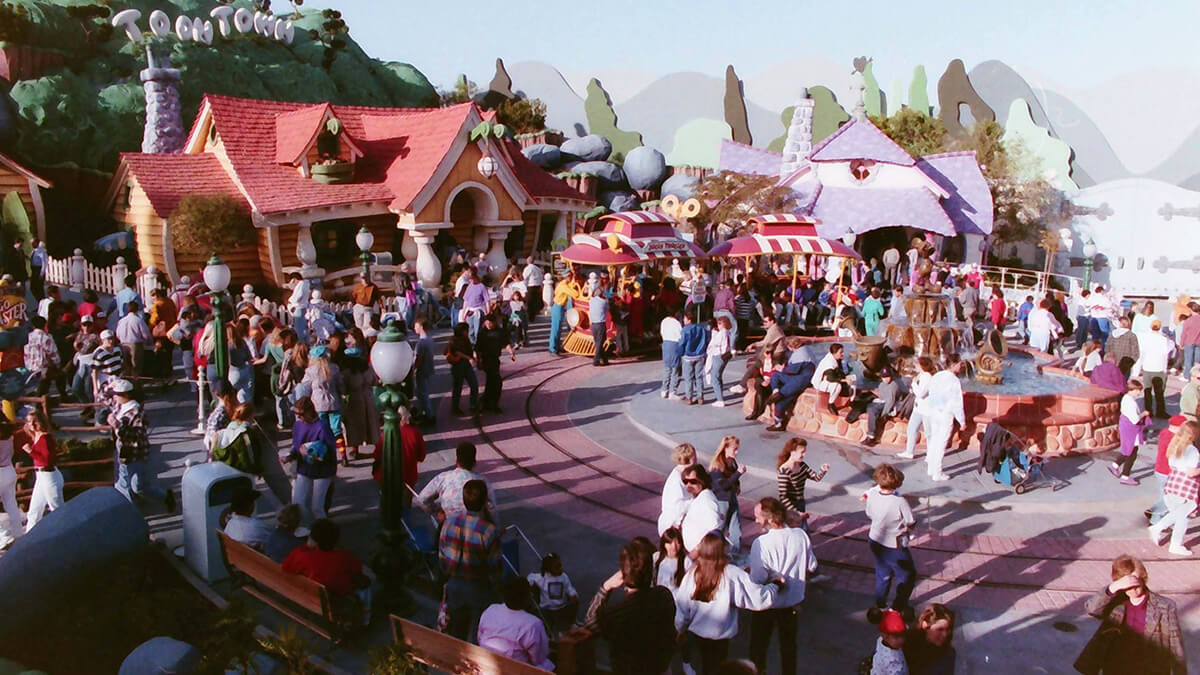
Disneyland in Anaheim, California, holds a special place in the hearts of Disney fans worldwide, I mean heck, it’s where the magic began after all. Over the years it’s become a place that people visit in search of memorable experiences. One fan favorite area of the park is Mickey’s Toontown, a unique land that lets guests step right into the colorful, “Toony” world of Disney animation. With the recent reimagining of the land and the introduction of Micky and Minnies Runaway Railway, have you ever wondered how this land came to be?
There is a fascinating backstory of how Mickey’s Toontown came into existence. It’s a tale of strategic vision, the influence of Disney executives, and a commitment to meeting the needs of Disney’s valued guests.
The Beginning: Mickey’s Birthdayland
The story of Mickey’s Toontown starts with Mickey’s Birthdayland at Walt Disney World’s Magic Kingdom. Opened in 1988 to celebrate Mickey Mouse’s 60th birthday, this temporary attraction was met with such overwhelming popularity that it inspired Disney executives to think bigger. The idea was to create a permanent, immersive land where guests could step into the animated world of Mickey Mouse and his friends.
In the early ’90s, Disneyland was in need of a refresh. Michael Eisner, the visionary leader of The Walt Disney Company at the time, had an audacious idea: create a brand-new land in Disneyland that would celebrate Disney characters in a whole new way. This was the birth of Mickey’s Toontown.
Initially, Disney’s creative minds toyed with various concepts, including the idea of crafting a 100-Acre Woods or a land inspired by the Muppets. However, the turning point came when they considered the success of “Who Framed Roger Rabbit.” This film’s popularity and the desire to capitalize on contemporary trends set the stage for Toontown’s creation.
From Concept to Reality: The Birth of Toontown
In 1993, Mickey’s Toontown opened its gates at Disneyland, marking the first time in Disney Park history where guests could experience a fully realized, three-dimensional world of animation. This new land was not just a collection of attractions but a living, breathing community where Disney characters “lived,” worked, and played.
Building Challenges: Innovative Solutions
The design of Mickey’s Toontown broke new ground in theme park aesthetics. Imagineers were tasked with bringing the two-dimensional world of cartoons into a three-dimensional space. This led to the creation of over 2000 custom-built props and structures that embodied the ‘squash and stretch’ principle of animation, giving Toontown its distinctiveness.
And then there was also the challenge of hiding the Team Disney Anaheim building, which bore a striking resemblance to a giant hotdog. The Imagineers had to think creatively, using balloon tests and imaginative landscaping to seamlessly integrate Toontown into the larger park.
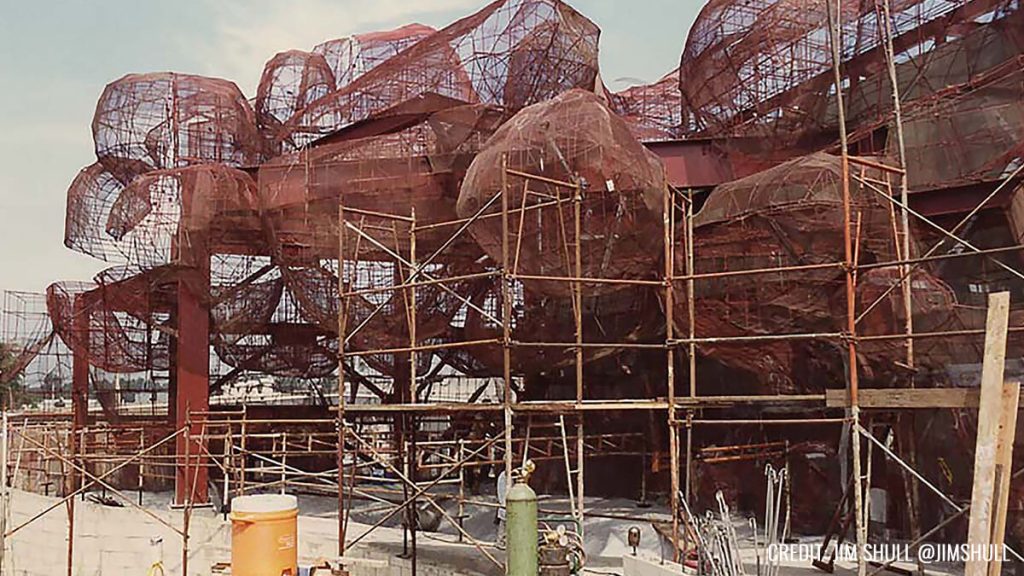
Key Attractions: Bringing Animation to Life
Mickey’s Toontown featured several groundbreaking attractions. “Roger Rabbit’s Car Toon Spin,” inspired by the movie “Who Framed Roger Rabbit,” became a staple of Toontown, offering an innovative ride experience. Gadget’s Go-Coaster, though initially conceived as a Rescue Rangers-themed ride, became a hit with younger visitors, proving that innovative design could create memorable experiences for all ages.
Another crown jewel of Toontown is Mickey’s House, a walkthrough attraction that allowed guests to explore the home of Mickey Mouse himself. This attraction was more than just a house; it was a carefully crafted piece of Disney lore. The house was designed in the American Craftsman style, reflecting the era when Mickey would have theoretically purchased his first home in Hollywood. The attention to detail was meticulous, with over 2000 hand-crafted, custom-built props, ensuring that every corner of the house was brimming with character and charm. Interestingly, the design of Mickey’s House was inspired by a real home in Wichita Falls, making it a unique blend of real-world inspiration and Disney magic.
Mickey’s House also showcased Disney’s commitment to creating interactive and engaging experiences. Guests could make themselves at home, sitting in Mickey’s chair, listening to the radio, and exploring the many mementos and references to Mickey’s animated adventures throughout the years. This approach to attraction design – where storytelling and interactivity merged seamlessly – was a defining characteristic of ToonTown’s success.
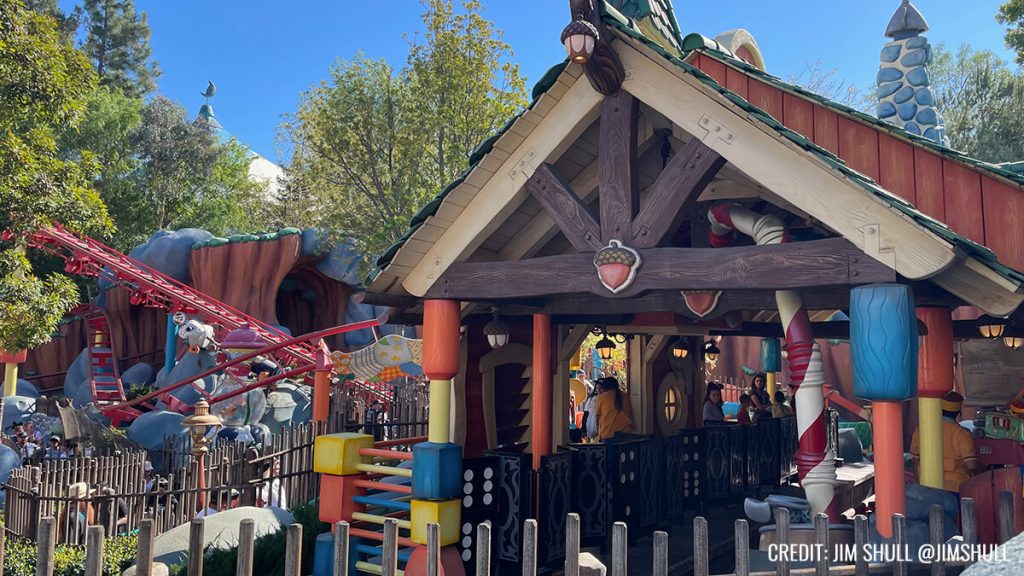
Executive Decisions: Shaping ToonTown’s Unique Attractions
The development of Mickey’s Toontown wasn’t just about creative imagination; it was significantly influenced by strategic decisions from Disney executives. One notable input came from Jeffrey Katzenberg, who suggested incorporating a Rescue Rangers-themed ride. This idea was a reflection of the broader Disney strategy to integrate popular contemporary characters and themes into the park, ensuring that the attractions remained relevant and engaging for visitors.
In addition to Katzenberg’s influence, Frank Wells, the then-President of The Walt Disney Company, played a key role in the strategic launch of Toontown’s attractions. His decision to delay the opening of “Roger Rabbit’s Car Toon Spin” until a year after Toontown’s debut was a calculated move. It was designed to maintain public interest in the park by offering new experiences over time, thereby giving guests more reasons to return to Disneyland.
These executive decisions highlight the careful planning and foresight that went into making Toontown a dynamic and continuously appealing part of Disneyland. By integrating current trends and strategically planning the rollout of attractions, Disney executives ensured that Toontown would not only capture the hearts of visitors upon its opening but would continue to draw them back for new experiences in the years to follow.
Global Influence: Toontown’s Worldwide Appeal
The concept of Mickey’s Toontown resonated so strongly that it was replicated at Tokyo Disneyland and influenced elements in Disneyland Paris and Hong Kong Disneyland. Each park’s version of Toontown maintained the core essence of the original while adapting to its cultural and logistical environment.
Evolution and Reimagining: Toontown Today
As we approach the present day, Mickey’s Toontown has recently undergone a significant reimagining to welcome “Mickey & Minnie’s Runaway Railway” in 2023. This refurbishment aimed to enhance the land’s interactivity and appeal to a new generation of Disney fans, all while retaining the charm that has made ToonTown a beloved destination for nearly three decades.
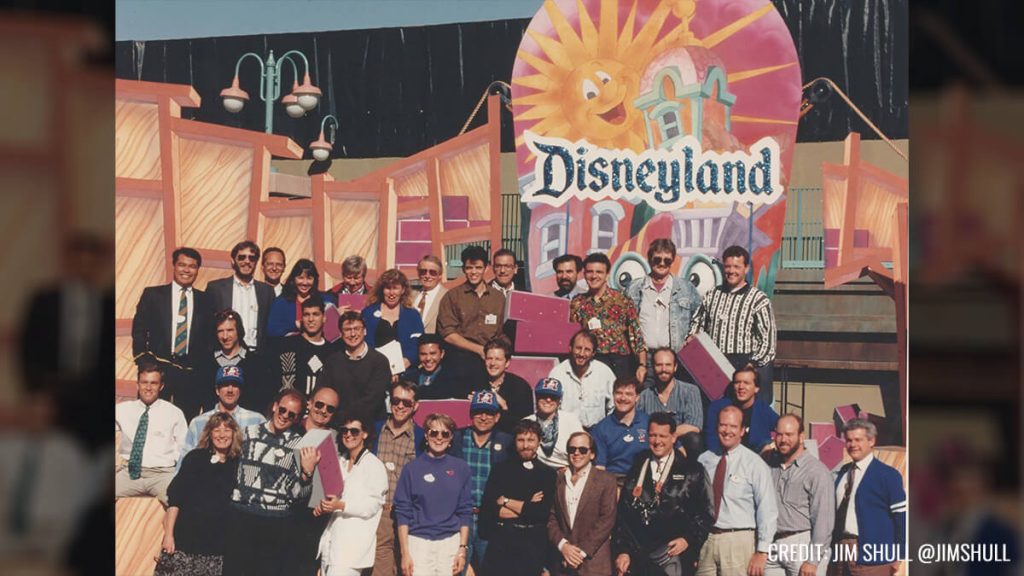
Dive Deeper into ToonTown’s Story
Want to know more about Mickey’s Toontown and hear some fascinating behind-the-scenes stories, then check out the latest episode of Disney Unpacked on Patreon @JimHillMedia. In this episode, the main Imagineer who worked on the Toontown project shares lots of interesting stories and details that you can’t find anywhere else. It’s full of great information and fun facts, so be sure to give it a listen!
History
Unpacking the History of the Pixar Place Hotel
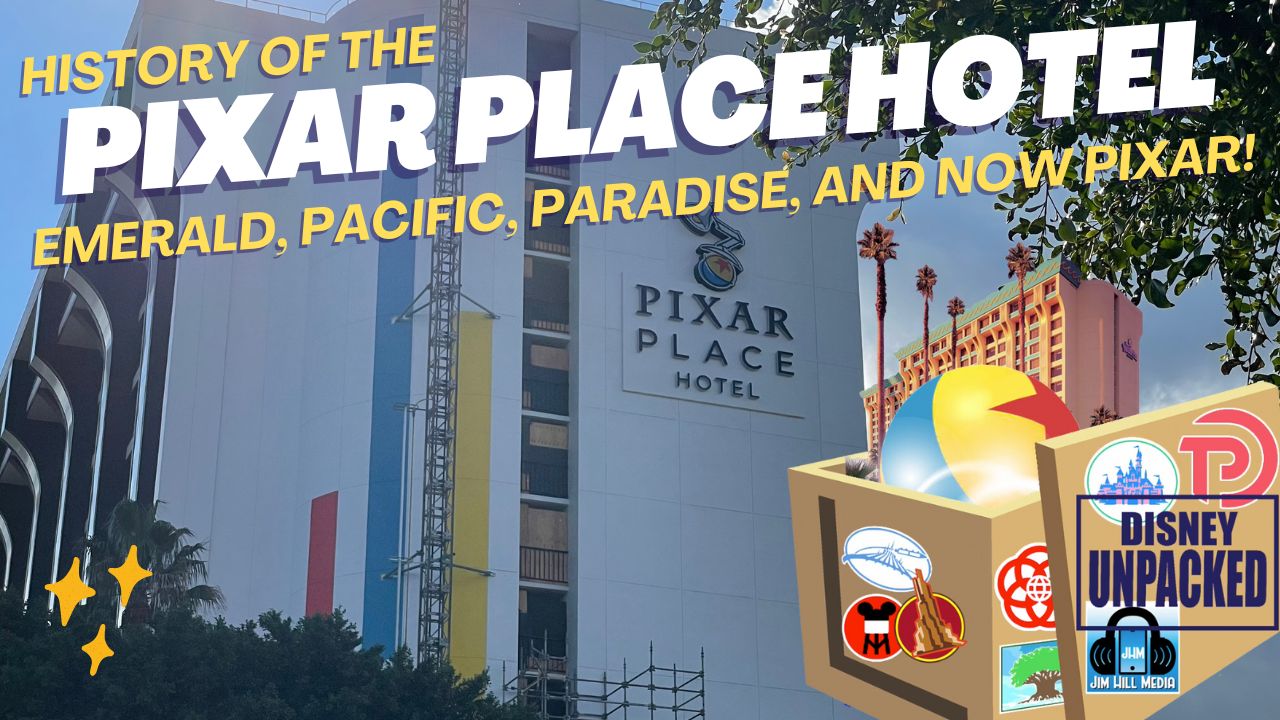
Pixar Place Hotel, the newly unveiled 15-story tower at the Disneyland Resort, has been making waves in the Disney community. With its unique Pixar-themed design, it promises to be a favorite among visitors.
However, before we delve into this exciting addition to the Disneyland Resort, let’s take a look at the fascinating history of this remarkable hotel.
The Emergence of the Disneyland Hotel
To truly appreciate the story of the Pixar Place Hotel, we must turn back the clock to the early days of Disneyland. While Walt Disney had the visionary ideas and funding to create the iconic theme park, he faced a challenge when it came to providing accommodations for the park’s visitors. This is where his friend Jack Wrather enters the picture.
Jack Wrather, a fellow pioneer in the television industry, stepped in to assist Walt Disney in realizing his dream. Thanks to the success of the “Lassie” TV show produced by Wrather’s company, he had the financial means to build a hotel right across from Disneyland.
The result was the Disneyland Hotel, which opened its doors in October 1955. Interestingly, the early incarnation of this hotel had more of a motel feel than a hotel, with two-story buildings reminiscent of the roadside motels popular during the 1950s. The initial Disneyland Hotel consisted of modest structures that catered to visitors looking for affordable lodging close to the park. While the rooms were basic, it marked the beginning of something extraordinary.
The Evolution: From Emerald of Anaheim to Paradise Pier
As Disneyland’s popularity continued to soar, so did the demand for expansion and improved accommodations. In 1962, the addition of an 11-story tower transformed the Disneyland Hotel, marking a significant transition from a motel to a full-fledged hotel.
The addition of the 11-story tower elevated the Disneyland Hotel into a more prominent presence on the Anaheim skyline. At the time, it was the tallest structure in all of Orange County. The hotel’s prime location across from Disneyland made it an ideal choice for visitors. With the introduction of the monorail linking the park and the hotel, accessibility became even more convenient. Unique features like the Japanese-themed reflecting pools added to the hotel’s charm, reflecting a cultural influence that extended beyond Disney’s borders.
Japanese Tourism and Its Impact
During the 1960s and 1970s, Disneyland was attracting visitors from all corners of the world, including Japan. A significant number of Japanese tourists flocked to Anaheim to experience Walt Disney’s creation. To cater to this growing market, it wasn’t just the Disneyland Hotel that aimed to capture the attention of Japanese tourists. The Japanese Village in Buena Park, inspired by a similar attraction in Nara, Japan, was another significant spot.
These attractions sought to provide a taste of Japanese culture and hospitality, showcasing elements like tea ceremonies and beautiful ponds with rare carp and black swans. However, the Japanese Village closed its doors in 1975, likely due to the highly competitive nature of the Southern California tourist market.
The Emergence of the Emerald of Anaheim
With the surge in Japanese tourism, an opportunity arose—the construction of the Emerald of Anaheim, later known as the Disneyland Pacific Hotel. In May 1984, this 15-story hotel opened its doors.
What made the Emerald unique was its ownership. It was built not by The Walt Disney Company or the Oriental Land Company (which operated Tokyo Disneyland) but by the Tokyu Group. This group of Japanese businessmen already had a pair of hotels in Hawaii and saw potential in Anaheim’s proximity to Disneyland. Thus, they decided to embark on this new venture, specifically designed to cater to Japanese tourists looking to experience Southern California.
Financial Challenges and a Changing Landscape
The late 1980s brought about two significant financial crises in Japan—the crash of the NIKKEI stock market and the collapse of the Japanese real estate market. These crises had far-reaching effects, causing Japanese tourists to postpone or cancel their trips to the United States. As a result, reservations at the Emerald of Anaheim dwindled.
To adapt to these challenging times, the Tokyu Group merged the Emerald brand with its Pacific hotel chain, attempting to weather the storm. However, the financial turmoil took its toll on the Emerald, and changes were imminent.
The Transition to the Disneyland Pacific Hotel
In 1995, The Walt Disney Company took a significant step by purchasing the hotel formerly known as the Emerald of Anaheim for $35 million. This acquisition marked a change in the hotel’s fortunes. With Disney now in control, the hotel underwent a name change, becoming the Disneyland Pacific Hotel.
Transformation to Paradise Pier
The next phase of transformation occurred when Disney decided to rebrand the hotel as Paradise Pier Hotel. This decision aligned with Disney’s broader vision for the Disneyland Resort.
While the structural changes were limited, the hotel underwent a significant cosmetic makeover. Its exterior was painted to complement the color scheme of Paradise Pier, and wave-shaped crenellations adorned the rooftop, creating an illusion of seaside charm. This transformation was Disney’s attempt to seamlessly integrate the hotel into the Paradise Pier theme of Disney’s California Adventure Park.
Looking Beyond Paradise Pier: The Shift to Pixar Place
In 2018, Disneyland Resort rebranded Paradise Pier as Pixar Pier, a thematic area dedicated to celebrating the beloved characters and stories from Pixar Animation Studios. As a part of this transition, it became evident that the hotel formally known as the Disneyland Pacific Hotel could no longer maintain its Paradise Pier theme.
With Pixar Pier in full swing and two successful Pixar-themed hotels (Toy Story Hotels in Shanghai Disneyland and Tokyo Disneyland), Disney decided to embark on a new venture—a hotel that would celebrate the vast world of Pixar. The result is Pixar Place Hotel, a 15-story tower that embraces the characters and stories from multiple Pixar movies and shorts. This fully Pixar-themed hotel is a first of its kind in the United States.
The Future of Pixar Place and Disneyland Resort
As we look ahead to the future, the Disneyland Resort continues to evolve. The recent news of a proposed $1.9 billion expansion as part of the Disneyland Forward project indicates that the area surrounding Pixar Place is expected to see further changes. Disneyland’s rich history and innovative spirit continue to shape its destiny.
In conclusion, the history of the Pixar Place Hotel is a testament to the ever-changing landscape of Disneyland Resort. From its humble beginnings as the Disneyland Hotel to its transformation into the fully Pixar-themed Pixar Place Hotel, this establishment has undergone several iterations. As Disneyland Resort continues to grow and adapt, we can only imagine what exciting developments lie ahead for this iconic destination.
If you want to hear more stories about the History of the Pixar Place hotel, check our special edition of Disney Unpacked over on YouTube.
Stay tuned for more updates and developments as we continue to explore the fascinating world of Disney, one story at a time.
-
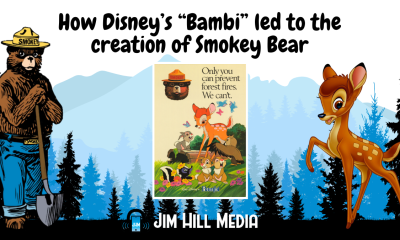
 Film & Movies12 months ago
Film & Movies12 months agoHow Disney’s “Bambi” led to the creation of Smokey Bear
-

 Theme Parks & Themed Entertainment7 months ago
Theme Parks & Themed Entertainment7 months agoDisney’s Forgotten Halloween Event: The Original Little Monsters on Main Street
-

 Theme Parks & Themed Entertainment7 months ago
Theme Parks & Themed Entertainment7 months agoThe Story of Mickey’s Not-So-Scary Halloween Party: From One Night to a Halloween Family Tradition
-

 Film & Movies7 months ago
Film & Movies7 months agoHow “An American Tail” Led to Disney’s “Hocus Pocus”
-

 Theme Parks & Themed Entertainment5 months ago
Theme Parks & Themed Entertainment5 months agoDisney and Macy’s 90-Year Thanksgiving Day Parade Partnership: From Mickey’s First Balloon to Minnie’s Big Debut
-

 Television & Shows3 months ago
Television & Shows3 months agoHow the Creators of South Park Tricked A-List Celebrities to Roast Universal – “Your Studio & You”
-

 History2 months ago
History2 months agoThe Super Bowl & Disney: The Untold Story Behind ‘I’m Going to Disneyland!’
-

 Podcast3 days ago
Podcast3 days agoEpic Universal Podcast – Aztec Dancers, Mariachis, Tequila, and Ceremonial Sacrifices?! (Ep. 45)






